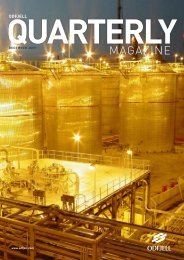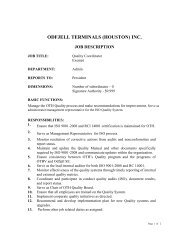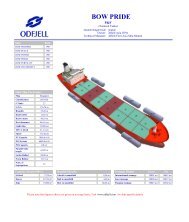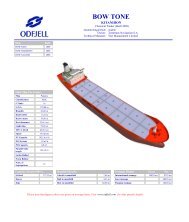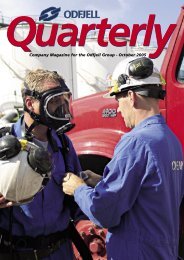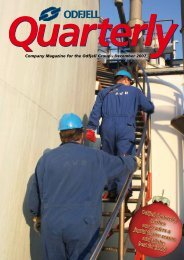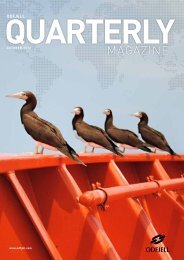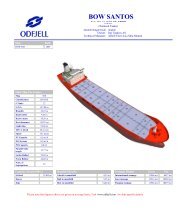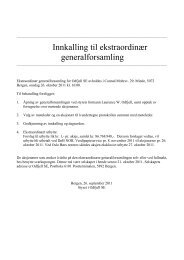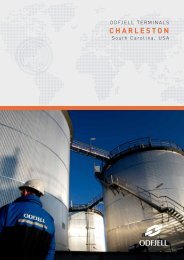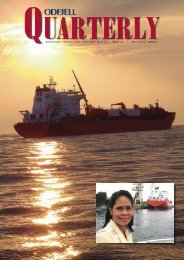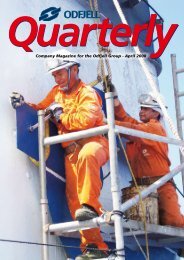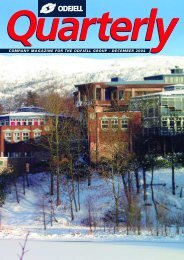You also want an ePaper? Increase the reach of your titles
YUMPU automatically turns print PDFs into web optimized ePapers that Google loves.
QM Corner<br />
If it is unsafe - don’t do it!<br />
Prevention is better than cure<br />
It’s all about the little things!<br />
By Leif Gunnar Alvær<br />
All business activities, not least in the<br />
chemical trade, involve an element<br />
of risk. Therefore proactive risk<br />
management is needed in all units.<br />
− Identification of hazards<br />
− Risk assessment<br />
− Risk prevention, and<br />
− Risk protection<br />
Risk management in everyday life<br />
When crossing the street we usually do a<br />
quick risk evaluation.<br />
Hazard: May get hit by a car.<br />
Assessment: Consequence may<br />
be serious. Without<br />
precautions the probability<br />
is high.<br />
Prevention: Run quickly. Look out.<br />
Move to a safer place.<br />
Wait for green light.<br />
Avoid crossing.<br />
Protection: Use helmet, boots and<br />
gloves. Have good medical<br />
care. Have insurance.<br />
As you see there are many possibilities.<br />
In most cases reducing the probability<br />
of an adverse occurrence is better than<br />
reducing its consequences.<br />
Perception of what is an acceptable risk<br />
level is individual, and it could be difficult<br />
to judge how safe is “safe enough”.<br />
It may be better to ask yourself: “Is it<br />
unsafe”? If the answer is: “Yes”, don’t<br />
do it!<br />
More formal everyday risk management<br />
activities are referred to as Safe Job<br />
Analysis (SJA) or Task Risk Assessment<br />
(TRA).<br />
Systematic risk management<br />
There are many threats to consider<br />
in our global business, and their<br />
consequences may be serious injury,<br />
fire, groundings, pollution, lost clients,<br />
fines or ruin. But, hazards need not<br />
be as dangerous if we apply active and<br />
systematic risk management to handle<br />
them. Good knowledge, best practices,<br />
experience feedback and proper working<br />
procedures reduce the probability of<br />
something going wrong. Personal<br />
protection, life saving equipment,<br />
contingency preparedness and insurance<br />
are factors that may reduce the possible<br />
consequences if something nevertheless<br />
should go wrong.<br />
To avoid accidents or even disasters<br />
we must make sure that what we have<br />
decided to do to manage the risk is<br />
implemented. Ensuring compliance with<br />
plans and procedures is another piece of<br />
the same story – quality management.<br />
CORPORATE QUALITY<br />
MANAGEMENT MANUAL<br />
Table of Contents<br />
Definitions<br />
Introduction<br />
2006 Q2<br />
Mission and Policies<br />
Organisational structures<br />
<strong>2008</strong> Q1<br />
Responsibilities<br />
2006 Q4<br />
Human Resource Management 2007 Q2<br />
Common Directives<br />
2007 Q4<br />
Processes and elements of<br />
Quality Management<br />
2007 Q3<br />
Quality Management System 2007 Q3<br />
Quality Assurance and Improvement 2006 Q3<br />
Event Analysis<br />
<strong>2008</strong> Q2<br />
HSE Management<br />
2007 Q1<br />
Risk Management<br />
<strong>2008</strong> Q4<br />
In today’s tough market it’s an objective<br />
in itself to operate as effective as<br />
possible, something we all aim for on a<br />
daily basis. The brokers strive towards<br />
maximum tonnage utilisation, the<br />
operators for voyage and port turnaround<br />
optimisation. Our port captains<br />
further assist our agents with ensuring<br />
maximum efficiency in our port calls.<br />
The same applies for our vessels,<br />
where masters and chiefs all work to<br />
achieve the most efficient usage of their<br />
respective vessels. Small adjustments<br />
can mean huge savings.<br />
An example of the latter; one of our<br />
vessels had an ETA Port Said 06:00 am.<br />
To reach the convoy she was not required<br />
to arrive before 19:00 hrs, with that<br />
meant a waiting time at the anchorage<br />
for about 13hrs. However, the operator<br />
in agreement with the captain decided<br />
to reduce the speed, causing the vessel<br />
to arrive at 15:30 instead of 06:00. The<br />
vessel had a net saving of more than 45<br />
mt fuel which amounts to thousands of<br />
US dollars. All because the master and<br />
the operator were alert and focused.<br />
Energy saving is good for the<br />
environment and the economy<br />
Energy saving is obviously targeted<br />
throughout our organisation, and <strong>Odfjell</strong><br />
Tankers recognises the need for a<br />
common strategy on how to utilise the<br />
energy. <strong>Odfjell</strong> Tankers has therefore<br />
proactively initiated a project called<br />
Energy Management Project (EMP). The<br />
purpose of this project is to work towards<br />
a common Energy Management Strategy.<br />
A great deal of the EMP will then be to<br />
identify best practices and distribute this<br />
knowledge to all vessels. Moreover, the<br />
better we become to utilize the energy,<br />
we are not only saving the environment,<br />
we are also saving costs.<br />
Members of the EMP: From left Leif Gunnar Alvær, Siri Anne Mjåtvedt, Tony Martin Fjellanger,<br />
Erik Hjortland. Sigmund Larsen, Geir Bjørndalen and Geir Almestad were not present when the<br />
photo was taken.<br />
A multi-disciplinary project<br />
The EMP is multi disciplinary with<br />
members from operations, chartering,<br />
ship management and technology.<br />
A significant key success factor of<br />
the project is of course an open and<br />
constructive communication with our<br />
seafarers. We therefore encourage<br />
everyone with questions, possible<br />
initiatives or just plain criticism, to<br />
contact us. We have already received<br />
good initiatives from some of our vessels<br />
and superintendents. As a wise man<br />
once said; “Don’t reinvent the wheel, just<br />
realign it.”<br />
Weather routing<br />
Currently we have started a few<br />
initiatives, and more are to follow.<br />
Firstly we are testing weather routing.<br />
Weather routing is based on the master<br />
informing a third party provider with<br />
voyage relevant data. This includes<br />
departure/arrival, trim etc. The master<br />
then receives a recommended route<br />
suggestion based on actual weather data<br />
and weather forecasts. This will ensure<br />
that the vessel can choose not only the<br />
safest route, but also the route with the<br />
shortest sailing time. Better information,<br />
shorter and safer voyages not only<br />
lightens the master’s burden onboard<br />
but also saves us energy.<br />
“Energy Management is all about the<br />
little things.”<br />
For feedback, questions or good<br />
suggestions, please use<br />
energy.management@odfjell.com<br />
16 <strong>Odfjell</strong> <strong>Quarterly</strong> <strong>December</strong> <strong>2008</strong> <strong>Odfjell</strong> <strong>Quarterly</strong> <strong>December</strong> <strong>2008</strong> 17



